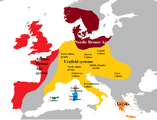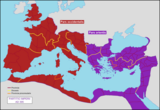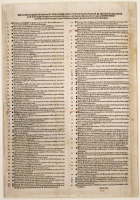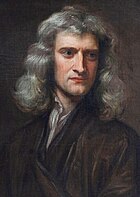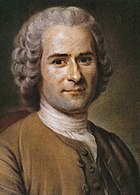History of Europe

The history of Europe is traditionally divided into four time periods: prehistoric Europe (prior to about 800 BC), classical antiquity (800 BC to AD 500), the Middle Ages (AD 500–1500), and the modern era (since AD 1500).
The first
The
Prehistory of Europe
Paleolithic
Nevertheless, the definitive advance of these technologies is made by the
Around 16,000 BC, Europe witnessed the appearance of a new culture, known as
Neolithic and Copper Age

Evidence of permanent settlement dates from the 8th millennium BC in the Balkans. The

Around this time, in the 5th millennium BC the Varna culture evolved. In 4700 – 4200 BC, the Solnitsata town, believed to be the oldest prehistoric town in Europe, flourished.[4][5]
-
Neolithic expansion in Europe, 7000-4000 BC
-
Late Neolithic Europe, c. 5000-3500 BC
Ancient Europe
Bronze Age
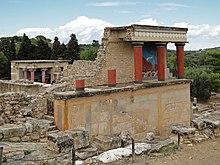
The first well-known literate civilization in Europe was the Minoan civilization that arose on the island of Crete and flourished from approximately the 27th century BC to the 15th century BC.[6]
The Minoans were replaced by the
Mycenaean artefacts have been found well outside the limits of the Mycenean world.
Quite unlike the Minoans, whose society benefited from trade, the Mycenaeans advanced through conquest. Mycenaean civilization was dominated by a warrior aristocracy. Around 1400 BC, the Mycenaeans extended their control to Crete, the centre of the Minoan civilization, and adopted a form of the Minoan script (called Linear A) to write their early form of Greek in Linear B.
The Mycenaean civilization perished with the
The Bronze Age collapse may be seen in the context of a technological history that saw the slow spread of
The Tumulus culture and the following Urnfield culture of central Europe were part of the origin of the Roman and Greek cultures.[16]
-
Indo-European migrations from c. 4000-1500 BC according to the Kurgan hypothesis
-
Late Bronze Age Europe, c. 1300-900 BC
Classical Antiquity
Classical antiquity, also known as the classical era, classical period, classical age, or simply antiquity,[17] is the period of cultural history between the 8th century BC and the 5th century AD comprising the interwoven civilizations of ancient Greece and ancient Rome known together as the Greco-Roman world, centered on the Mediterranean Basin. It is the period during which ancient Greece and ancient Rome flourished and had major influence throughout much of Europe, North Africa, and West Asia.[18][19]
Ancient Greece
The
The most powerful city-states were

The Hellenic city-states established colonies on the shores of the
Hellenic infighting left Greek city states vulnerable, and Philip II of Macedon united the Greek city states under his control. The son of Philip II, known as Alexander the Great, invaded neighboring Persia, toppled and incorporated its domains, as well as invading Egypt and going as far off as India, increasing contact with people and cultures in these regions that marked the beginning of the Hellenistic period.
After the death of Alexander the Great, his empire split into multiple kingdoms ruled by his generals, the Diadochi. The Diadochi fought against each other in a series of conflicts called the Wars of the Diadochi. In the beginning of the 2nd century BC, only three major kingdoms remained: the Ptolemaic Egypt, the Seleucid Empire and Macedonia. These kingdoms spread Greek culture to regions as far away as Bactria.[22]
Ancient Rome

Much of Greek learning was assimilated by the nascent Roman state as it expanded outward from Italy, taking advantage of its enemies' inability to unite: the only challenge to Roman ascent came from the
The

In the 4th century, the emperors
The Roman Empire had been repeatedly attacked by invading armies from Northern Europe and in 476, Rome finally
-
Europe in the year 301 BC
-
TheRoman republicand its neighbours in 58 BC
-
The Roman Empire at its greatest extent in 117 AD, under the emperor Trajan
-
The partition of the Roman Empire in 395, at the death of Theodosius I: the Western Roman Empire is shown in red and the Eastern Roman Empire is shown in purple
Late Antiquity and Migration Period

When Emperor Constantine had reconquered Rome under the banner of the cross in 312, he soon afterwards issued the Edict of Milan in 313 (preceded by the Edict of Serdica in 311), declaring the legality of Christianity in the Roman Empire. In addition, Constantine officially shifted the capital of the Roman Empire from Rome to the Greek town of Byzantium, which he renamed Nova Roma – it was later named Constantinople ("City of Constantine").
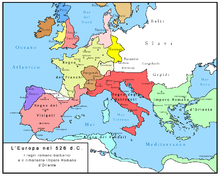
Roman authority in the Western part of the empire had collapsed, and a power vacuum left in the wake of this collapse; the central organization, institutions, laws and power of Rome had broken down, resulting in many areas being open to invasion by migrating tribes. Over time, feudalism and manorialism arose, providing for division of land and labour, as well as a broad if uneven hierarchy of law and protection. These localised hierarchies were based on the bond of common people to the land on which they worked, and to a lord, who would provide and administer both local law to settle disputes among the peasants, as well as protection from outside invaders.
The western provinces soon were to be dominated by three great powers: first, the
In Italy, Theodoric the Great began the cultural romanisation of the new world he had constructed. He made Ravenna a centre of Romano-Greek culture of art and his court fostered a flowering of literature and philosophy in Latin. In Iberia, King Chindasuinth created the Visigothic Code. [25]
In the Eastern part the dominant state was the remaining Eastern Roman Empire.
In the feudal system, new princes and kings arose, the most powerful of which was arguably the Frankish ruler Charlemagne. In 800, Charlemagne, reinforced by his massive territorial conquests, was crowned Emperor of the Romans by Pope Leo III, solidifying his power in western Europe. Charlemagne's reign marked the beginning of a new Germanic Roman Empire in the west, the Holy Roman Empire. Outside his borders, new forces were gathering. The Kievan Rus' were marking out their territory, a Great Moravia was growing, while the Angles and the Saxons were securing their borders.
For the duration of the 6th century, the
Post-classical and Medieval Europe
The Middle Ages are commonly dated from the
Byzantium
Many consider Emperor
Early Middle Ages
The Early Middle Ages span roughly five centuries from 500 to 1000.[35]
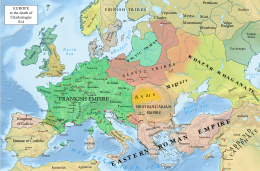
In the East and
From the 7th century Byzantine history was greatly affected by the rise of Islam and the
The Muslim conquest of Hispania began when the
The
Feudal Christendom

The Holy Roman Empire emerged around 800, as Charlemagne, King of the Franks and part of the Carolingian dynasty, was crowned by the pope as emperor. His empire based in modern France, the Low Countries and Germany expanded into modern Hungary, Italy, Bohemia, Lower Saxony and Spain. He and his father received substantial help from an alliance with the Pope, who wanted help against the Lombards.[40] His death marked the beginning of the end of the dynasty, which collapsed entirely by 888. The fragmentation of power led to semi-autonomy in the region, and has been defined as a critical starting point for the formation of states in Europe.[41]
To the east,
In eastern Europe, Volga Bulgaria became an Islamic state in 921, after Almış I converted to Islam under the missionary efforts of Ahmad ibn Fadlan.[43]
Slavery in the early medieval period had mostly died out in western Europe by about the year 1000 AD, replaced by serfdom. It lingered longer in England and in peripheral areas linked to the Muslim world, where slavery continued to flourish. Church rules suppressed slavery of Christians. Most historians argue the transition was quite abrupt around 1000, but some see a gradual transition from about 300 to 1000.[44]
High Middle Ages

In 1054, the East–West Schism occurred between the two remaining Christian seats in Rome and Constantinople (modern Istanbul).
The High Middle Ages of the 11th, 12th, and 13th centuries show a rapidly increasing population of Europe, which caused great social and political change from the preceding era. By 1250, the robust population increase greatly benefited the economy, reaching levels it would not see again in some areas until the 19th century.[45]
From about the year 1000 onwards, Western Europe saw the last of the barbarian invasions and became more politically organized. The
Bulgarian sovereignty was re-established with the
In the 11th century, populations north of the
The High Middle Ages produced many different forms of intellectual, spiritual and
Holy wars

After the East–West Schism, Western Christianity was adopted by the newly created kingdoms of Central Europe: Poland, Hungary and Bohemia. The Roman Catholic Church developed as a major power, leading to conflicts between the Pope and emperor. The geographic reach of the Roman Catholic Church expanded enormously due to the conversions of pagan kings (Scandinavia, Lithuania, Poland, Hungary), the Christian Reconquista of Al-Andalus, and the Crusades. Most of Europe was Roman Catholic in the 15th century.
Early signs of the rebirth of civilization in western Europe began to appear in the 11th century as trade started again in Italy, leading to the economic and cultural growth of independent city-states such as Venice and Florence; at the same time, nation-states began to take form in places such as France, England, Spain, and Portugal, although the process of their formation (usually marked by rivalry between the monarchy, the aristocratic feudal lords and the church) actually took several centuries. These new nation-states began writing in their own cultural vernaculars, instead of the traditional Latin. Notable figures of this movement would include Dante Alighieri and Christine de Pizan. The Holy Roman Empire, essentially based in Germany and Italy, further fragmented into a myriad of feudal principalities or small city states, whose subjection to the emperor was only formal.
The 14th century, when the
In the Northern Europe,
Late Middle Ages

The Late Middle Ages spanned around the 14th and late 15th centuries.[48] Around 1300, centuries of European prosperity and growth came to a halt. A series of famines and plagues, such as the Great Famine of 1315–1317 and the Black Death, killed people in a matter of days, reducing the population of some areas by half as many survivors fled. Kishlansky reports:
- The Black Death touched every aspect of life, hastening a process of social, economic, and cultural transformation already underway.... Fields were abandoned, workplaces stood idle, international trade was suspended. Traditional bonds of kinship, village, and even religion were broken amid the horrors of death, flight, and failed expectations. "People cared no more for dead men than we care for dead goats," wrote one survivor.[49]
Depopulation caused labor to become scarcer; the survivors were better paid and peasants could drop some of the burdens of feudalism. There was also social unrest; France and England experienced serious peasant risings including the
Beginning in the 14th century, the Baltic Sea became one of the most important trade routes. The Hanseatic League, an alliance of trading cities, facilitated the absorption of vast areas of Poland, Lithuania, and Livonia into trade with other European countries. This fed the growth of powerful states in this part of Europe including Poland–Lithuania, Hungary, Bohemia, and Muscovy later on. The conventional end of the Middle Ages is usually associated with the fall of the city of Constantinople and of the Byzantine Empire to the Ottoman Turks in 1453. The Turks made the city the capital of their Ottoman Empire, which lasted until 1922 and included Egypt, Syria, and most of the Balkans. The Ottoman wars in Europe marked an essential part of the history of the continent.
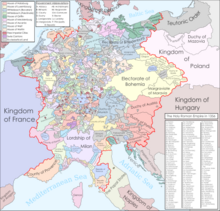
A key 15th-century development was the advent of the movable type of printing press circa 1439 in Mainz,[51] building upon the impetus provided by the prior introduction of paper from China via the Arabs in the High Middle Ages.[52] The adoption of the technology across the continent at dazzling speed for the remaining part of the 15th century would usher a revolution and by 1500 over 200 cities in Europe had presses that printed between 8 and 20 million books.[51]
Early modern Europe

The Early Modern period spans the centuries between the
Renaissance
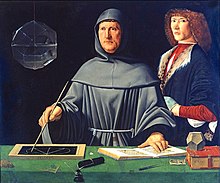
Despite these crises, the 14th century was also a time of great progress within the arts and sciences. A renewed interest in ancient
The Scientific Revolution took place in Europe starting towards the second half of the Renaissance period, with the 1543 Nicolaus Copernicus publication De revolutionibus orbium coelestium (On the Revolutions of the Heavenly Spheres) often cited as its beginning.
Exploration and trade

Toward the end of the period, an era of discovery began. The growth of the Ottoman Empire, culminating in the fall of Constantinople in 1453, cut off trading possibilities with the east. Western Europe was forced to discover new trading routes, as happened with Columbus' travel to the Americas in 1492, and Vasco da Gama's circumnavigation of India and Africa in 1498.
The numerous wars did not prevent European states from exploring and conquering wide portions of the world, from Africa to Asia and the newly discovered Americas. In the 15th century,
Reformation
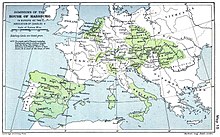
With the development of the
During this period corruption in the Catholic Church led to a sharp backlash in the Protestant Reformation. It gained many followers especially among princes and kings seeking a stronger state by ending the influence of the Catholic Church. Figures other than
The Protestant Reformation also led to a strong reform movement in the Catholic Church called the
Unlike many European countries, the Polish–Lithuanian Commonwealth and Hungary were more tolerant. While still enforcing the predominance of Catholicism, they continued to allow the large religious minorities to maintain their faiths, traditions and customs. The Polish–Lithuanian Commonwealth became divided among Catholics, Protestants, Orthodox, Jews and a small Muslim population.
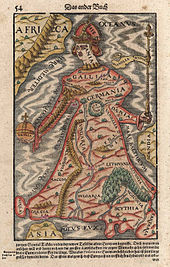
Another development was the idea of 'European superiority'. There was a movement by some such as Montaigne that regarded the non-Europeans as a better, more natural and primitive people. Post services were founded all over Europe, which allowed a humanistic interconnected network of intellectuals across Europe, despite religious divisions. However, the Roman Catholic Church banned many leading scientific works; this led to an intellectual advantage for Protestant countries, where the banning of books was regionally organised. Francis Bacon and other advocates of science tried to create unity in Europe by focusing on the unity in nature.1 In the 15th century, at the end of the Middle Ages, powerful sovereign states were appearing, built by the New Monarchs who were centralising power in France, England, and Spain. On the other hand, the Parliament in the Polish–Lithuanian Commonwealth grew in power, taking legislative rights from the Polish king. The new state power was contested by parliaments in other countries especially England. New kinds of states emerged which were co-operation agreements among territorial rulers, cities, farmer republics and knights.

Mercantilism and colonial expansion

The
Colonial expansion continued in the following centuries (with some setbacks, such as successful wars of independence in the
This expansion helped the economy of the countries owning them. Trade flourished, because of the minor stability of the empires. By the late 16th century, American silver accounted for one-fifth of Spain's total budget.[57][58] The French colony of Saint-Domingue was one of richest European colonies in the 18th century, operating on a plantation economy fueled by slave labor. During the period of French rule, cash crops produced in Saint-Domingue comprised thirty percent of total French trade while its sugar exports represented forty percent of the Atlantic market.[59][60]
Crisis of the 17th century
The 17th century was an era of crisis.[61][62] Many historians have rejected the idea, while others promote it as an invaluable insight into the warfare, politics, economics,[63] and even art.[64] The Thirty Years' War (1618–1648) focused attention on the massive horrors that wars could bring to entire populations.[65] The 1640s in particular saw more state breakdowns around the world than any previous or subsequent period.[61][62] The Polish–Lithuanian Commonwealth, the largest state in Europe, temporarily disappeared. In addition, there were secessions and upheavals in several parts of the Spanish empire, the world's first global empire. In Britain the entire Stuart monarchy (England, Scotland, Ireland, and its North American colonies) rebelled. Political insurgency and a spate of popular revolts seldom equalled shook the foundations of most states in Europe and Asia. More wars took place around the world in the mid-17th century than in almost any other period of recorded history. Across the Northern Hemisphere, the mid-17th century experienced almost unprecedented death rates.
Age of absolutism
The "absolute" rule of powerful monarchs such as
Throughout the early part of this period, capitalism (through mercantilism) was replacing feudalism as the principal form of economic organisation, at least in the western half of Europe. The expanding colonial frontiers resulted in a
The Reformation had profound effects on the unity of Europe. Not only were nations divided one from another by their religious orientation, but some states were torn apart internally by religious strife, avidly fostered by their external enemies. France suffered this fate in the 16th century in the series of conflicts known as the French Wars of Religion, which ended in the triumph of the Bourbon Dynasty. England settled down under Elizabeth I to a moderate Anglicanism. Much of modern-day Germany was made up of numerous small sovereign states under the theoretical framework of the Holy Roman Empire, which was further divided along internally drawn sectarian lines. The Polish–Lithuanian Commonwealth is notable in this time for its religious indifference and general immunity to European religious strife.
Thirty Years' War 1618–1648
The
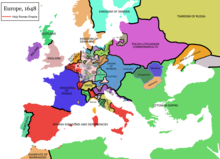
After the
From the Union of Krewo, central and eastern Europe was dominated by

War of the Spanish Succession
The
- That Treaty [of Utrecht], which ushered in the stable and characteristic period of Eighteenth-Century civilization, marked the end of danger to Europe from the old French monarchy, and it marked a change of no less significance to the world at large – the maritime, commercial and financial supremacy of Great Britain.[73]
Prussia
Russia

Russia fought numerous wars to achieve rapid expansion toward the east – i.e. Siberia, Far East, south, to the Black Sea, and south-east and to central Asia. Russia boasted a large and powerful army, a very large and complex internal bureaucracy, and a splendid court that rivaled Paris and London. However the government was living far beyond its means and seized Church lands, leaving organized religion in a weak condition. Throughout the 18th century Russia remained "a poor, backward, overwhelmingly agricultural, and illiterate country."[76]
Enlightenment
The Enlightenment was a powerful, widespread cultural movement of intellectuals beginning in late 17th-century Europe emphasizing the power of reason rather than tradition; it was especially favourable to science (especially Isaac Newton's physics) and hostile to religious orthodoxy (especially of the Catholic Church).[77] It sought to analyze and reform society using reason, to challenge ideas grounded in tradition and faith, and to advance knowledge through the scientific method. It promoted scientific thought, skepticism, and intellectual interchange.[78] The Enlightenment was a revolution in human thought. This new way of thinking was that rational thought begins with clearly stated principles, uses correct logic to arrive at conclusions, tests the conclusions against evidence, and then revises the principles in light of the evidence.[78]
Enlightenment thinkers opposed superstition. Some Enlightenment thinkers collaborated with Enlightened despots, absolutist rulers who attempted to forcibly impose some of the new ideas about government into practice. The ideas of the Enlightenment exerted significant influence on the culture, politics, and governments of Europe.[79]
Originating in the 17th century, it was sparked by philosophers Francis Bacon, Baruch Spinoza, John Locke, Pierre Bayle, Voltaire, Francis Hutcheson, David Hume and physicist Isaac Newton.[80] Ruling princes often endorsed and fostered these figures and even attempted to apply their ideas of government in what was known as enlightened absolutism. The Scientific Revolution is closely tied to the Enlightenment, as its discoveries overturned many traditional concepts and introduced new perspectives on nature and man's place within it. The Enlightenment flourished until about 1790–1800, at which point the Enlightenment, with its emphasis on reason, gave way to Romanticism, which placed a new emphasis on emotion; a Counter-Enlightenment began to increase in prominence.
In France, Enlightenment was based in the
Norman Davies has argued that
From revolution to imperialism (1789–1914)
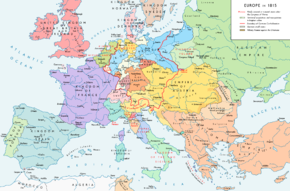
The "
Industrial Revolution
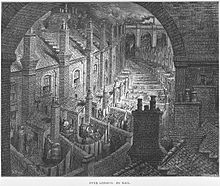
The Industrial Revolution saw major changes in agriculture, manufacturing, and transport impacted Britain and subsequently spread to the United States and Western Europe. Technological advancements, most notably the utilization of the steam engine, were major catalysts in the industrialisation process. It started in England and Scotland in the mid-18th century with the mechanisation of the textile industries, the development of iron-making techniques and the increased use of coal as the main fuel. Trade expansion was enabled by the introduction of canals, improved roads and railways. The introduction of steam power (fuelled primarily by coal) and powered machinery (mainly in textile manufacturing) underpinned the dramatic increases in production capacity.[86] The development of all-metal machine tools in the first two decades of the 19th century facilitated the manufacture of more production machines for manufacturing in other industries. The effects spread throughout Western Europe and North America during the 19th century, eventually affecting most of the world.[87]
Era of the French Revolution
Historians
- In 1789 France fell into revolution, and the world has never since been the same. The French Revolution was by far the most momentous upheaval of the whole revolutionary age. It replaced the "old regime" with "modern society," and at its extreme phase became very radical, so much so that all later revolutionary movements have looked back to it as a predecessor to themselves.... From the 1760s to 1848, the role of France was decisive.[88]
The era of the French Revolution and the subsequent Napoleonic wars was a difficult time for monarchs. Tsar
The American Revolution (1775–1783) was the first successful revolt of a colony against a European power. It rejected aristocracy and established a republican form of government that attracted worldwide attention.[90] The French Revolution (1789–1804) was a product of the same democratic forces in the Atlantic World and had an even greater impact.[91] French historian François Aulard says:
- From the social point of view, the Revolution consisted in the suppression of what was called the feudal system, in the emancipation of the individual, in greater division of landed property, the abolition of the privileges of noble birth, the establishment of equality, the simplification of life.... The French Revolution differed from other revolutions in being not merely national, for it aimed at benefiting all humanity."[92]
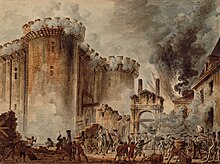
French intervention in the
At the time the assembly wanted to create a
On 20 September 1792 the
Napoleon

On 12 June 1812 Napoleon
Impact of the French Revolution
Roberts finds that the Revolutionary and Napoleonic wars, from 1793 to 1815, caused 4 million deaths (of whom 1 million were civilians); 1.4 million were French.[93]
Outside France the Revolution had a major impact. Its ideas became widespread. Roberts argues that Napoleon was responsible for key ideas of the modern world, so that, "meritocracy, equality before the law, property rights, religious toleration, modern secular education, sound finances, and so on-were protected, consolidated, codified, and geographically extended by Napoleon during his 16 years of power."[94]
Furthermore, the French armies in the 1790s and 1800s directly overthrew feudal remains in much of western Europe. They liberalised property laws, ended seigneurial dues, abolished the guild of merchants and craftsmen to facilitate entrepreneurship, legalised divorce, closed the Jewish ghettos and made Jews equal to everyone else. The Inquisition ended as did the Holy Roman Empire. The power of church courts and religious authority was sharply reduced and equality under the law was proclaimed for all men.[95]
France conquered Belgium and turned it into another province of France. It conquered the Netherlands, and made it a client state. It took control of the German areas on the left bank of the Rhine River and set up a puppet Confederation of the Rhine. It conquered Switzerland and most of Italy, setting up a series of puppet states. The result was glory and an infusion of much needed money from the conquered lands. However the enemies of France, led by Britain, formed a Second Coalition in 1799 (with Britain joined by Russia, the Ottoman Empire and Austria). It scored a series of victories that rolled back French successes, and trapped the French Army in Egypt. Napoleon slipped through the British blockade in October 1799, returning to Paris, where he overthrew the government and made himself the ruler.[96][97]
Napoleon conquered most of Italy in the name of the French Revolution in 1797–99. He split up Austria's holdings and set up a series of new republics, complete with new codes of law and abolition of feudal privileges. Napoleon's Cisalpine Republic was centered on Milan; Genoa became a republic; the Roman Republic was formed as well as the small Ligurian Republic around Genoa. The Neapolitan Republic was formed around Naples, but it lasted only five months. He later formed the Kingdom of Italy, with his brother as King. In addition, France turned the Netherlands into the Batavian Republic, and Switzerland into the Helvetic Republic. All these new countries were satellites of France, and had to pay large subsidies to Paris, as well as provide military support for Napoleon's wars. Their political and administrative systems were modernized, the metric system introduced, and trade barriers reduced. Jewish ghettos were abolished. Belgium and Piedmont became integral parts of France.[98]

Most of the new nations were abolished and returned to prewar owners in 1814. However, Artz emphasizes the benefits the Italians gained from the French Revolution:
- For nearly two decades the Italians had excellent codes of law, a fair system of taxation, a better economic situation, and more religious and intellectual toleration than they had known for centuries.... Everywhere old physical, economic, and intellectual barriers had been thrown down and the Italians had begun to be aware of a common nationality.[99]
Likewise in Switzerland the long-term impact of the French Revolution has been assessed by Martin:
- It proclaimed the equality of citizens before the law, equality of languages, freedom of thought and faith; it created a Swiss citizenship, basis of our modern nationality, and the separation of powers, of which the old regime had no conception; it suppressed internal tariffs and other economic restraints; it unified weights and measures, reformed civil and penal law, authorized mixed marriages (between Catholics and Protestants), suppressed torture and improved justice; it developed education and public works.[100]
The greatest impact came in France itself. In addition to effects similar to those in Italy and Switzerland, France saw the introduction of the principle of legal equality, and the downgrading of the once powerful and rich Catholic Church. Power became centralized in Paris, with its strong bureaucracy and an army supplied by conscripting all young men. French politics were permanently polarized – new names were given, "left" and "right" for the supporters and opponents of the principles of the Revolution.
Religion
By the 19th century, governments increasingly took over traditional religious roles, paying much more attention to efficiency and uniformity than to religiosity. Secular bodies took control of education away from the churches, abolished taxes and tithes for the support of established religions, and excluded bishops from the upper houses. Secular laws increasingly regulated marriage and divorce, and maintaining birth and death registers became the duty of local officials. Although the numerous religious denominations in the United States founded many colleges and universities, that was almost exclusively a state function across Europe. Imperial powers protected Christian missionaries in African and Asian colonies.[101] In France and other largely Catholic nations, anti-clerical political movements tried to reduce the role of the Catholic Church. Likewise briefly in Germany in the 1870s there was a fierce Kulturkampf (culture war) against Catholics, but the Catholics successfully fought back. The Catholic Church concentrated more power in the papacy and fought against secularism and socialism. It sponsored devotional reforms that gained wide support among the churchgoers.[102]
Nations rising
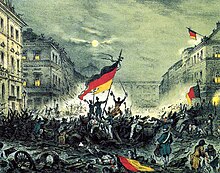
The political development of nationalism and the push for popular sovereignty culminated with the ethnic/national revolutions of Europe. During the 19th century nationalism became one of the most significant political and social forces in history; it is typically listed among the top causes of World War I.[103][104] Most European states had become constitutional monarchies by 1871, and Germany and Italy merged many small city-states to become united nation-states. Germany in particular increasingly dominated the continent in economics and political power. Meanwhile, on a global scale, Great Britain, with its far-flung British Empire, unmatched Royal Navy, and powerful bankers, became the world's first global power. The sun never set on its territories, while an informal empire operated through British financiers, entrepreneurs, traders and engineers who established operations in many countries, and largely dominated Latin America. The British were especially famous for financing and constructing railways around the world.[105]
Napoleon's conquests of the German and Italian states around 1800–1806 played a major role in stimulating nationalism and demand for national unity.[106]
Germany
In the German states east of Prussia Napoleon abolished many of the old or medieval relics, such as dissolving the Holy Roman Empire in 1806.[107] He imposed rational legal systems and his organization of the Confederation of the Rhine in 1806 promoted a feeling of German nationalism. In the 1860s it was Prussian chancellor Otto von Bismarck who achieved German unification in 1870 after the many smaller states followed Prussia's leadership in wars against Denmark, Austria and France.[108]
Italy

Serbia

For centuries the
In 1918, the region of
Greece
The Greek drive for independence from the Ottoman Empire inspired supporters across Christian Europe, especially in Britain. France, Russia and Britain intervened to make this nationalist dream become reality with the Greek War of Independence (1821-1829/1830).[113]
Bulgaria
Bulgarian modern nationalism emerged under Ottoman rule in the late 18th and early 19th century. An autonomous Bulgarian Exarchate was established in 1870/1872 for the diocese of Bulgaria as well as for those, wherein at least two-thirds of Orthodox Christians were willing to join it. The April Uprising in 1876 indirectly resulted in the re-establishment of Bulgaria in 1878.
Poland
In the 1790s, Germany, Russia and Austria partitioned Poland. Napoleon set up the Duchy of Warsaw, igniting a spirit of Polish nationalism. Russia took it over in 1815 as Congress Poland with the tsar as King of Poland. Large-scale nationalist revolts erupted in 1830 and 1863–64 but were harshly crushed by Russia, which tried to Russify the Polish language, culture and religion. The collapse of the Russian Empire in the First World War enabled the major powers to reestablish an independent Second Polish Republic, which survived until 1939. Meanwhile, Poles in areas controlled by Germany moved into heavy industry but their religion came under attack by Bismarck in the Kulturkampf of the 1870s. The Poles joined German Catholics in a well-organized new Centre Party, and defeated Bismarck politically. He responded by stopping the harassment and cooperating with the Centre Party.[114][115]
Spain

After the War of the Spanish Succession, the assimilation of the Crown of Aragon by the Castilian Crown through the Decrees of Nova planta was the first step in the creation of the Spanish nation state, through the imposition of the political and cultural characteristics of the dominant ethnic group, in this case the Castilians, over those of other ethnic groups, who became national minorities to be assimilated.[116][117] Since the political unification of 1714, Spanish assimilation policies towards Catalan-speaking territories (Catalonia, Valencia, the Balearic Islands, part of Aragon) and other national minorities have been a historical constant.[118][119][120] The nationalization process accelerated in the 19th century, in parallel to the origin of Spanish nationalism, the social, political and ideological movement that tried to shape a Spanish national identity based on the Castilian model, in conflict with the other historical nations of the State. These nationalist policies, sometimes very aggressive,[121][122][123][124] and still in force,[125][126][127][128] are the seed of repeated territorial conflicts within the State.
Education
An important component of nationalism was the study of the nation's heritage, emphasizing the national language and literary culture. This stimulated, and was in turn strongly supported by, the emergence of national educational systems. Latin gave way to the national language, and compulsory education, with strong support from modernizers and the media, became standard in Germany and eventually other West European nations. Voting reforms extended the franchise. Every country developed a sense of national origins – the historical accuracy was less important than the motivation toward patriotism. Universal compulsory education was extended to girls at the elementary level. By the 1890s, strong movements emerged in some countries, including France, Germany and the United States, to extend compulsory education to the secondary level.[129][130]
Ideological coalitions

After the defeat of revolutionary France, the great powers tried to restore the situation which existed before 1789. The 1815
Radical intellectuals looked to the
The middle classes and businessmen promoted liberalism, free trade and capitalism. Aristocratic elements concentrated in government service, the military and the established churches. Nationalist movements (in Germany, Italy, Poland, Hungary, and elsewhere) sought national unification and/or liberation from foreign rule. As a result, the period between 1815 and 1871 saw a large number of revolutionary attempts and independence wars. Greece successfully revolted against Ottoman rule in the 1820s.[134]
France under Napoleon III

Napoleon III, nephew of Napoleon I, parlayed his famous name and to widespread popularity across France. He returned from exile in 1848, promising to stabilize the chaotic political situation.[135] He was elected president and maneuvered successfully to name himself Emperor, a move approved later by a large majority of the French electorate. The first part of his Imperial term brought many important reforms, facilitated by Napoleon's control of the lawmaking body, the government, and the French Armed Forces. Hundreds of old Republican leaders were arrested and deported. Napoleon controlled the media and censored the news. In compensation for the loss of freedom, Napoleon gave the people new hospitals and asylums, beautified and modernized Paris, and built a modern railroad and transportation system that dramatically improved commerce. The economy grew, but industrialization was not as rapid as Britain, and France depended largely on small family-oriented firms as opposed to the large companies that were emerging in the United States and Germany. France was on the winning side in the Crimean War (1854–56), but after 1858 Napoleon's foreign-policy was less and less successful. Foreign-policy blunders finally destroyed his reign in 1870–71. His empire collapsed after being defeated in the Franco-Prussian War.[136][137]
France became a republic, but until the 1880s there was a strong popular demand for monarchy.

Bismarck's Germany
From his base in Prussia,
Austrian and Russian empires
The power of nationalism to create new states was irresistible in the 19th century, and the process could lead to collapse in the absence of a strong nationalism.
The Russian Empire likewise brought together a multitude of languages and cultures, so that its military defeat in the First World War led to multiple splits that created independent Finland, Latvia, Lithuania, Estonia, and Poland, and briefly independent Ukraine, Armenia, Georgia, and Azerbaijan.[142]
Imperialism
Subsequent major European colonial empires included the
By the mid-19th century, the Ottoman Empire had declined. This instigated the Crimean War in 1854 and began a tenser period of minor clashes among the globe-spanning empires of Europe. In the second half of the 19th century, the Kingdom of Sardinia and the Kingdom of Prussia carried out a series of wars that resulted in the creation of Italy and Germany as nation-states, significantly changing the balance of power in Europe. From 1870, Otto von Bismarck engineered a German hegemony that put France in a critical situation. It slowly rebuilt its relationships, seeking alliances with Russia and Britain to control the growing power of Germany. In this way, two opposing sides – the Triple Alliance of 1882 (Germany, Austria-Hungary and Italy) and the Triple Entente of 1907 (Britain, France and Russia) – formed in Europe, escalating military forces and alliances.
1914–45: two world wars
World War I

After the relative peace of most of the 19th century, the rivalry between European powers, compounded by rising nationalism among ethnic groups, exploded in 1914, when World War I started.[143] Over 65 million European soldiers were mobilised from 1914 to 1918; 20 million soldiers and civilians died.[144] On one side were Germany, Austria-Hungary, the Ottoman Empire and Bulgaria (the Central Powers/Triple Alliance), while on the other side stood Serbia and the Triple Entente(France, Britain and Russia), which were joined by Italy in 1915, Romania in 1916 and the United States in 1917. The Western Front involved especially brutal combat without any territorial gains by either side. Single battles like Verdun and the Somme killed hundreds of thousands. Czarist Russia collapsed in the February Revolution of 1917 and Germany claimed victory on the Eastern Front. After eight months of liberal rule, the October Revolution brought Vladimir Lenin and the Bolsheviks to power, leading to the creation of the Soviet Union. With American entry into the war in 1917, and the failure of Germany's spring 1918 offensive, Germany had run out of manpower. Germany's allies, Austria-Hungary and the Ottoman Empire, surrendered and dissolved, followed by Germany on 11 November 1918.[145][146]

The world war was settled by the victors at the
Interwar
In the Treaty of Versailles (1919) the winners recognised the new states (Poland, Czechoslovakia, Hungary, Austria, Yugoslavia, Finland, Estonia, Latvia, Lithuania) created in central Europe from the defunct German, Austro-Hungarian and Russian empires, based on national (ethnic) self-determination. It was a peaceful era with a few small wars before 1922 such as the Ukrainian–Soviet War (1917–1921) and the Polish–Soviet War (1919–1921). Prosperity was widespread, and the major cities sponsored a youth culture called the "Roaring Twenties" or "Jazz Age".[150]
The Allied victory in the First World War seemed to mark the triumph of
Great Depression: 1929–39
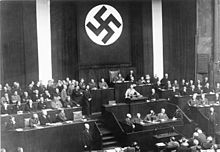
After the Wall Street Crash of 1929, most of the world sank into a Great Depression; prices and profits fell and unemployment soared. The worst hit sectors included heavy industry, export-oriented agriculture, mining and lumbering, and construction. World trade fell by two-thirds.[154][155]
In most of Europe, many nations turned to dictators and authoritarian regimes. The most momentous change of government came when
Italy conquered Ethiopia in 1931.[157] The Spanish Civil War (1936–1939) was won by the rebels (the Nationalist faction), led by Francisco Franco. The civil war did not escalate into a larger conflict, but did become a worldwide ideological battleground that pitted the left, the communist movement and many liberals against Catholics, conservatives, and fascists. Britain, France and the US remained neutral. Worldwide there was a decline in pacifism and a growing sense that another world war was imminent.[158]
World War II

In 1938
Over the next year the Germans started to suffer a series of defeats. War raged between the Axis Powers (Germany, Italy, and Japan) and the Allied Forces (British Empire, Soviet Union, and the United States). The Allied Forces won in North Africa, invaded Italy in 1943, and recaptured France in 1944. In 1945 Germany itself was invaded from the east by the Soviet Union and from the west by the other Allies. As the Red Army conquered the Reichstag in the Battle of Berlin, Hitler committed suicide and Germany surrendered.[160] World War II was the deadliest conflict in human history, causing between 50 and 80 million deaths, the majority of whom were civilians (approximately 38 to 55 million).[161]
This period was also marked by systematic genocide. In 1942–45, separately from the war-related deaths, the
Cold War era

The world wars ended the pre-eminent position of Britain, France and Germany in Europe and the world.
Communist states were imposed by the Red Army in the East, while parliamentary democracy became dominant in the West. Most historians point to its success as the product of exhaustion with war and dictatorship, and the promise of continued economic prosperity.
Economic recovery

The United States gave away about $20 billion in Marshall Plan grants and other funding to Western Europe, 1945 to 1951. Historian Michael J. Hogan argues that American aid was critical in stabilizing the economy and politics of Western Europe. It brought in modern management that dramatically increased productivity, and encouraged cooperation between labor and management, and among states. Local Communist parties were opposed, and they lost prestige and influence and a role in government. In strategic terms, says Hogan, the Marshall Plan strengthened the West against the possibility of a communist invasion or political takeover.[164] However, the Marshall Plan's role in the rapid recovery has been debated. Most reject the idea that it only miraculously revived Europe, since the evidence shows that a general recovery was already under way. Economic historians Bradford De Long and Barry Eichengreen conclude:
- It was not large enough to have significantly accelerated recovery by financing investment, aiding the reconstruction of damaged infrastructure, or easing commodity bottlenecks. We argue, however, that the Marshall Plan did play a major role in setting the stage for post-World War II Western Europe's rapid growth. The conditions attached to Marshall Plan aid pushed European political economy in a direction that left its post World War II "mixed economies" with more "market" and less "controls" in the mix.[165]
The Soviet Union concentrated on its own recovery. It seized and transferred most of Germany's industrial plants and it exacted war reparations from East Germany, Hungary, Romania, and Bulgaria. It used trading arrangements deliberately designed to favor the Soviet Union. Moscow controlled the Communist parties that ruled the satellite states. Historian Mark Kramer concludes:
- The net outflow of resources from eastern Europe to the Soviet Union was approximately $15 billion to $20 billion in the first decade after World War II, an amount roughly equal to the total aid provided by the United States to western Europe under the Marshall Plan.[166]
Looking at the half century after the war historian Walter Lacquer concluded:
- "The postwar generations of European elites aimed to create more democratic societies. They wanted to reduce the extremes of wealth and poverty and provide essential social services in a way that prewar generations had not. They had had quite enough of unrest and conflict. For decades many Continental societies had more or less achieved these aims and had every reason to be proud of their progress. Europe was quiet and civilized. Europe's success was based on recent painful experience: the horrors of two world wars; the lessons of dictatorship; the experiences of fascism and communism. Above all, it was based on a feeling of European identity and common values – or so it appeared at the time."[167]
The post-war period witnessed a significant rise in the standard of living of the Western European working class.[168]
Western Europe's industrial nations in the 1970s were hit by a
Recent history

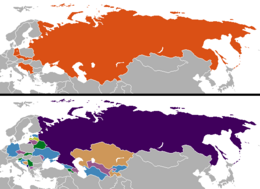
Western Europe began economic and then political integration, with the aim to unite the region and defend it. This process included organisations such as the
The EU did not participate in the Yugoslav Wars, and was divided on supporting the United States in the 2003–2011 Iraq War. NATO was part of the war in Afghanistan, but at a much lower level of involvement than the United States.
In the post–Cold War era, NATO and the EU have been gradually admitting most of the former members of the Warsaw Pact. In 2004, the EU gained 10 new members. (Estonia, Latvia, and Lithuania, which had been part of the Soviet Union; Czech Republic, Hungary, Poland, Slovakia, and Slovenia, five former-communist countries; Malta, and the divided island of Cyprus.) These were followed by Bulgaria and Romania in 2007. Russia's regime interpreted these expansions as violations against NATO's promise to not expand "one inch to the east" in 1990.[171] Russia engaged in bilateral disputes about gas supplies with Belarus and Ukraine which endangered the European supply, and engaged in a war with Georgia in 2008. Public opinion in the EU turned against enlargement, partially due to what was seen as over-eager expansion including Turkey gaining candidate status. The European Constitution was rejected in France and the Netherlands, and then (as the Treaty of Lisbon) in Ireland, although a second vote passed in Ireland in 2009.
The
Beginning in 2014, Ukraine has been in a state of revolution and unrest. On 16 March, a disputed referendum was held in Crimea leading to the de facto secession of Crimea and its largely internationally unrecognized annexation to the Russian Federation.
In June 2016, in a
According to the Wall Street Journal in 2021 as
Chronology
- 7000 BC: Neolithic in Europe begins.
- 4600 - 4200 BC: First European proto-civilisation, first golden artefacts and first fortified stone town - the Varna culture.[5][176][177][178][179][180]
- 5000 - 3500 BC: First European proto-script - the
- 3850 - 3600 BC: Malta's Temple period begins.
- 3500 BC: First European civilization, Minoan civilization, begins on Crete.
- 3000 BC: Indo-Europeansbegin a large-scale settlement of the continent.
- 2500 BC: Stonehenge is constructed.
- 2100 BC: First European script, Cretan hieroglyphs, is invented by Minoans.
- 1750 BC: Mycenaean civilizationbegins.
- 1600 BC: Thera.
- 1450 BC: Mycenaeans.
- 1200 BC:
- 1100 BC: Minoan civilization falls.
- 1050 BC: Mycenaean civilization falls after a period of palace destruction, marking the beginning of Greek Dark Ages.
- 900 BC: Etruscan civilization begins.
- 800 BC: Greek Dark Ages end, marking the beginning of classical antiquity.
- 753 BC: Traditional year of founding of Rome.
- 700 BC: Homer composes The Iliad, an epic poem that represents the first extended work of European literature.
- 509 BC: Roman Republic is created.
- 499 BC: Greco-Persian Wars begin.
- c. 480 BC: The Thracian Odrysian kingdom was founded as the most important Daco-Thracian state union.[184]
- 449 BC: End of Achaemid Empire.
- 440 BC: Herodotus defends Athenian political freedom in the Histories.
- 404 BC: Sparta wins the Peloponnesian War.
- 323 BC: Macedonian Empire(reaching far into Asia) fragments.
- 264 BC: Punic Wars begin.
- 146 BC: Punic Wars end with destruction of Carthage.
- 48 BC: Julius Caesar crosses the Rubicon river, marking the beginning of a civil war.
- 44 BC: Julius Caesar is murdered. The Roman Republic enters its terminal crisis.
- 27 BC: Establishment of the Roman Empire under Octavian.
AD
- 14 AD: Octaviandies.
- 30 or 33 AD: crucified.
- 45–55 (ca): First Christiancongregations in mainland Greece and in Rome.
- 68: First Roman imperial dynasty, Julio-Claudian, ends with suicide of Nero.
- 79: under the ashes.
- 117: Roman Empire reaches its territorial peak.
- 166: Antonine Plague begins.
- 293: Diocletian reorganizes the Empire by creating the Tetrarchy.
- 313: Constantine officially recognises Christianity, marking the end of the persecution of Christians.
- 330: Constantine makes Constantinople into his capital, a new Rome.
- 370: Huns first enter Europe.
- 395: Following the death of Eastern Roman Empire (later Byzantium) and the Western Roman Empire.
- 476: Odoacer captures Ravenna and deposes the last Roman emperor in the west: traditionally seen as the end date of the Western Roman Empire.
- 527: Justinian I is crowned emperor of Byzantium. Orders the editing of Corpus Juris Civilis, Digest (Roman law).
- 597: Beginning of Roman Catholic Christianization of Anglo-Saxon England(missions and churches had been in existence well before this date, but their contacts with Rome had been loose or nonexistent)
- 600: Saint Columbanususes the term "Europe" in a letter.
- 655: Jus patronatus.
- 681: Khan Asparukh leads the Bulgars and in a union with the numerous local Slavs invades the Byzantine Empire in the Battle of Ongal, creating Bulgaria.
- 718: Tervel of Bulgaria helps the Byzantine Empire stop the Arabic invasion of Europe, and breaks the siege of Constantinople.
- 722: Battle of Covadonga in the Iberian Peninsula. Pelayo, a noble Visigoth, defeats a Muslim army that tried to conquer the Cantabrian coast. This helps establish the Christian Kingdom of Asturias, and marks the beginning of the Reconquista.
- 732: At the Battle of Tours, the Franks stop the advance of the Arabs into Europe.
- 800: Coronation of Charlemagne as Holy Roman Emperor.
- 813: Third Council of Tours: Priests are ordered to preach in the native language of the population.
- 843: Treaty of Verdun.
- 863: Saints Cyril and Methodius arrive in Great Moravia, initiating Christian mission among the Slav peoples.
- 864: Boris I of Bulgaria officially baptises the whole nation, converting the non-Christian population from Tengrism, Slavic and other paganism to Christianity, and officially founding the Bulgarian Church
- 872: Unification of Norway.
- 886: Bulgarian students of Cyril and Methodius – Sava, Kliment, Naum, Gorazd, Angelariy – arrive back to Bulgaria, creating the Preslav and Ohrid Literary Schools.
- 893: The Cyrillic alphabet, developed during the 9th century AD at the Preslav Literary School in the First Bulgarian Empire, becomes the official Bulgarian alphabet.
- 895: Carpathian Basin.
- 917: In the Battle of Achelous (917) Bulgaria defeats the Byzantine Empire, and Simeon I of Bulgaria is proclaimed as emperor, thus Bulgaria becomes an empire.
- 962: Otto I of East Francia is crowned as "Emperor" by the Pope, beginning the Holy Roman Empire.
- 988 Kievan Rus adopts Christianity, often seen as the origin of the Russian Orthodox Church.
- 1054: Start of the East–West Schism, which divides the Christian church for centuries.
- 1066: Successful Norman Invasion of England by William the Conqueror.
- 1095: Pope Urban II calls for the First Crusade.
- 12th century: The 12th century in literature saw an increase in the number of texts. The Renaissance of the 12th century occurs.
- 1128: Battle of São Mamede, formation of Portuguese sovereignty.
- 1131: Birth of the Kingdom of Sicily
- 1185: Bulgarian sovereignty was reestablished with the anti-Byzantine uprising of the Bulgarians and Vlachs
- 1250: Death of emperor Frederick II; end of effective ability of emperors to exercise control in Italy.
- 1303: The period of the Crusades is over.
- 1309–1378: The Avignon Papacy
- 1315–1317: The Great Famine of 1315–1317 in Northern Europe
- 1341: Humanism", becomes the first poet laureatesince antiquity.
- 1337–1453: The Hundred Years' War between England and France.
- 1348–1351: Black Death kills about one-third of Europe's population.
- 1439: Printing Revolution.
- 1453: Fall of Constantinople to the Ottoman Turks.
- 1487: The Wars of the Roses end.
- 1492: The Reconquista ends in the Iberian Peninsula. A Spanish expeditionary group, commanded by Christopher Columbus, lands in the New World.
- 1497: Vasco da Gama departs to India starting direct trade with Asia.
- 1498: The Last Supper in Milan as the Renaissanceflourishes.
- 1508: Maximilian I the last ruling "King of the Romans" and the first "elected Emperor of the Romans".
- 1517: Reformation
- 1519: Ferdinand Magellan and Juan Sebastián Elcano begin first global circumnavigation. Their expedition returns in 1522.
- 1519: Hernán Cortés begins conquest of Mexico for Spain.
- 1532: Francisco Pizarro begins the conquest of Peru (the Inca Empire) for Spain.
- 1543: Nicolaus Copernicus publishes De revolutionibus orbium coelestium (On the Revolutions of the Celestial Spheres).
- 1547: The Grand Duchy of Moscow becomes the Tsardom of Russia.
- 1582: The introduction of the Gregorian calendar; Russia refuses to adopt it until 1918.
- 1610: Galileo Galilei uses his telescope to discover the moons of Jupiter.
- 1618: The Thirty Years' War brings massive devastation to central Europe.
- 1648: The Peace of Westphalia ends the Thirty Years' War, and introduces the principle of the integrity of the nation state.
- 1687: The Enlightenment.
- 1699: Treaty of Karlowitz concludes the Austro-Ottoman War. This marks the end of Ottoman control of Central Europe and the beginning of Ottoman stagnation, establishing the Habsburg monarchy as the dominant power in Central and Southeastern Europe.
- 1700: Outbreak of the War of the Spanish Succession and the Great Northern War. The first would check the aspirations of Louis XIV, king of France to dominate European affairs; the second would lead to Russia's emergence as a great power and a recognizably European state.
- 18th century: Age of Enlightenment spurs an intellectual renaissance across Europe.
- 1707: The Kingdom of Great Britain is formed by the union of the Kingdom of England and the Kingdom of Scotland.
- 1712: Thomas Newcomen invents first practical steam engine which begins Industrial Revolution in Britain.
- 1721: Foundation of the Russian Empire.
- 1775: James Watt invents a new efficient steam engine accelerating the Industrial Revolution in Britain.
- 1776: Adam Smith publishes The Wealth of Nations.
- 1784: Answering the Question: What Is Enlightenment?.
- 1789: Beginning of the French Revolution and end of the absolute monarchy in France.
- 1792–1802: French Revolutionary Wars.
- 1799: Napoleon comes to power, eventually consolidating his position as Emperor of the French.
- 1803–1815: Napoleonic Wars end in defeat of Napoleon.
- 1806: Napoleon abolishes the Holy Roman Empire.
- 1814–1815: Congress of Vienna; Treaty of Vienna; France is reduced to 1789 boundaries; Reactionary forces dominate across Europe.
- 1825: George Stephenson opens the Stockton and Darlington Railway the first steam train railway for passenger traffic in the world.
- 1830: The southern provinces secede from the United Kingdom of the Netherlands in the Belgian Revolution.
- 1836: Louis Daguerre invents first practical photographic method, in effect the first camera.
- 1838: SS Great Western, the first steamship built for regularly scheduled transatlantic crossings enters service.
- 1848: Revolutions of 1848 and publication of The Communist Manifesto.
- 1852: Start of the Crimean War, which ends in 1855 in a defeat for Russia.
- 1859: Charles Darwin publishes On the Origin of Species.
- 1861: Unification of Italy after victories by Giuseppe Garibaldi.
- 1866: First commercially successful transatlantic telegraph cable is completed.
- 1860s: Russia emancipates its serfs and Karl Marx completes the first volume of Das Kapital.
- 1870: Franco-Prussian War and the fall of the Second French Empire.
- 1871: Unification of Germany under the direction of Otto von Bismarck.
- 1873: Panic of 1873 occurs. The Long Depression begins.
- 1878: Re-establishment of Bulgaria, independence of Serbia, Montenegro and Romania
- 1885: Karl Benz invents Benz Patent-Motorwagen, the world's first automobile.
- 1885: First permanent citywide electrical tram system in Europe (in Sarajevo).
- 1895: Auguste and Louis Lumière begin exhibitions of projected films before the paying public with their cinematograph, a portable camera, printer, and projector.
- 1902: Guglielmo Marconi sends first transatlantic radio transmission.
- 1914: Archduke Franz Ferdinand of Austria is assassinated; World War I begins.
- 1917: Bolsheviks seize power in the Russian Revolution. The ensuing Russian Civil Warlasts until 1922.
- 1918: World War I ends with the defeat of Germany and the Central Powers. Ten million soldiers killed; collapse of Russian, German, Austrian, and Ottoman empires.
- 1918: Collapse of the German Empire and monarchic system; founding of Weimar Republic.
- 1918: Worldwide Spanish flu epidemic kills millions in Europe.
- 1918: Austro-Hungarian Empire dissolves.
- 1919: Versailles Treatystrips Germany of its colonies, several provinces and its navy and air force; limits army; Allies occupy western areas; reparations ordered.
- 1920: League of Nations begins operations; largely ineffective; defunct by 1939.
- 1921–22: Ireland divided; Irish Free State becomes independent and civil war erupts.
- 1922: Benito Mussolini and the Fascists take power in Italy.
- 1929: Worldwide Great Depression begins with stock market crash in New York City.
- 1933: Nazistake power in Germany.
- 1935: Italy conquers Ethiopia; League sanctions are ineffective.
- 1936: Start of the Spanish Civil War; ends in 1939 with victory of Nationalists who are aided by Germany and Italy.
- 1938: Germany escalates the persecution of Jews with Kristallnacht.
- 1938: Appeasement of Germany by Britain and France; Munich agreement splits Czechoslovakia; Germany seized the remainder in 1939.
- 1939: Britain and France hurriedly rearm; failed to arrange treaty with USSR.
- 1939: Adolf Hitler and Joseph Stalin agree partition of Eastern Europe in Molotov–Ribbentrop Pact.
- 1939: Second World War.
- 1940: Great Britain under Winston Churchill becomes the last nation to hold out against the Nazis after winning the Battle of Britain.
- 1941: U.S. begins large-scale lend-lease aid to Britain, Free France, the USSR and other Allies; Canada also provides financial aid.
- 1941: Germany invades the Soviet Union in Operation Barbarossa; fails to capture Moscow or Leningrad.
- 1942: Holocaust – a Final Solution, with the murder of 6 million Jews.
- 1943: After Stalingrad and Kursk, Soviet forces begin recapturing Nazi-occupied territory in the East.
- 1944: U.S., British and Canadian armed forces invade Nazi-occupied France at Normandy.
- 1945: Hitler commits suicide, Mussolini is executed. World War II ends with Europe in ruins and Germany defeated.
- 1945: United Nations formed.
- 1947: The British Empire begins a process of voluntarily dismantling with the granting of independence to India and Pakistan.
- 1947: Cold War begins as Europe is polarized East versus West.
- 1948–1951: U.S. provides large sums to rebuild Western Europe through the Marshall Plan; stimulates large-scale modernization of European industries and reduction of trade restrictions.
- 1949: The NATO alliance is established.
- 1955: USSR creates a rival military coalition, the Warsaw Pact.
- 1950: The Schuman Declaration begins the process of European integration.
- 1954: The French Empire begins to be dismantled; Withdraws from Vietnam.
- 1956: Suez Crisis signals the end of the effective power of the British Empire.
- 1956: Hungarian Uprising defeated by Soviet military forces.
- 1957: Treaties of Rome establish the European Economic Communityfrom 1958.
- 1962: The Second Vatican Council opens and begins a period of reform in the Catholic Church
- 1968: The May 1968 events in Francelead France to the brink of revolution.
- 1968: The Prague Spring is defeated by Warsaw Pact military forces. The Club of Rome is founded.
- 1973: Denmark, Ireland and the United Kingdom join the European Communities.
- 1980: The Solidarność movement under Lech Wałęsa begins open, overground opposition to the Communist rule in Poland.
- 1981: Greece joins the European Communities.
- 1985: Mikhail Gorbachev becomes leader of the Soviet Union and begins reforms which inadvertently leads to the fall of Communism and the Soviet Union.
- 1986: Portugal and Spain join the European Communities.
- 1986: Chernobyl disaster occurs, the worst nuclear disaster in history.
- 1989: Communism overthrown in all the Warsaw Pact countries except the Soviet Union. Fall of the Berlin Wall (opening of unrestrained border crossings between east and west, which effectively deprived the wall of any relevance).
- 1990: Reunification of Germany.
- 1991: Breakup of Yugoslavia and the beginning of the Yugoslav Wars.
- 1991: Dissolution of the Soviet Union and the creation of the Commonwealth of Independent States.
- 1993: Maastricht Treaty establishes the European Union.
- 1995: Austria, Finland and Sweden join the European Union.
- 1997–99: End of European colonial empires in Asia with the handover of Hong Kong and Macau to China.
- 2004: Slovenia, Hungary, the Czech Republic, Slovakia, Poland, Lithuania, Latvia, Estonia, Cyprus and Malta join the European Union.
- 2007: Bulgaria and Romania join the European Union.
- 2008: The Great Recession begins. Unemployment rises in some parts of Europe.
- 2013: Croatia joins the European Union.
- 2014: Revolution of Dignity in Ukraine and the beginning of the Russo-Ukrainian War.
- 2015: European migrant crisisstarts.
- 2020: The United Kingdom leaves the European Union.
- 2020-2023: COVID-19 pandemic in Europe, countries with the most cases are Russia, the United Kingdom, France, Spain, and Italy.
- 2022: Russian invasion of Ukraine opens with some of the most intense combat operations in Europe since the end of the Cold War.
- 2023: Finland joins NATO.
- 2024: Sweden joins NATO.
See also
- Genetic history of Europe
- History of the Balkans
- History of the Mediterranean region
- History of the Romani people
- History of Western civilization
- List of history journals#Europe
- List of largest European cities in history
- List of predecessors of sovereign states in Europe
- List of sovereign states by date of formation § Europe
- Major explorations after the Age of Discovery
- Timeline of European Union history
References
- PMID 29674591.
- S2CID 32726786.
- ^ "When the First Farmers Arrived in Europe, Inequality Evolved". Scientific American. 1 July 2020. Archived from the original on 25 May 2022. Retrieved 17 September 2022.
- ^ Squires, Nick (31 October 2012). "Archaeologists find Europe's most prehistoric town". The Daily Telegraph. Archived from the original on 12 January 2022. Retrieved 1 November 2012.
- ^ The Los Angeles Times. Archivedfrom the original on 4 May 2019. Retrieved 1 November 2012.
- ^ "Ancient Crete". Oxfordbibliographiesonline.com. 15 February 2010. Archived from the original on 30 May 2020. Retrieved 17 May 2012.
- ISBN 978-0-8155-5047-1. Archivedfrom the original on 27 April 2023. Retrieved 6 November 2020.
- ^ Tandy, p. xii. "Figure 1: Map of Epirus showing the locations of known sites with Mycenaean remains"; Tandy, p. 2. "The strongest evidence for Mycenaean presence in Epirus is found in the coastal zone of the lower Acheron River, which in antiquity emptied into a bay on the Ionian coast known from ancient sources as Glykys Limin (Figure 2-A)."
- ISBN 978-0-691-00880-6. Archivedfrom the original on 27 April 2023. Retrieved 6 November 2020.
- ^ "Aegeobalkan Prehistory – Mycenaean Sites". Archived from the original on 3 September 2015. Retrieved 17 May 2012.
- ^ The Synchronisation of Civilisations in the eastern Mediterranean in the Second Millennium BC III, Proceedings of the SCIEM 2000 – 2nd EuroConference, Vienna, 28 May – 1 June 2003
- ^ Use and appreciation of Mycenaean pottery in the Levant, Cyprus and Italy Archived 27 April 2023 at the Wayback Machine, Gert Jan van Wijngaarden, Amsterdam Archaeological Studies
- ^ The Mycenaeans and Italy: the archaeological and archaeometric ceramic evidence, University of Glasgow, Department of Archaeology
- ^ Emilio Peruzzi, Mycenaeans in early Latium, (Incunabula Graeca 75), Edizioni dell'Ateneo & Bizzarri, Roma, 1980
- ^ a b See A. Stoia and the other essays in M.L. Stig Sørensen and R. Thomas, eds., The Bronze Age: Iron Age Transition in Europe (Oxford) 1989, and T.A. Wertime and J.D. Muhly, The Coming of the Age of Iron (New Haven) 1980.
- ^ "Barbarian Europe and Early Iron Age Greece".
- ISBN 9781400836550.
- ISBN 9781473840959.
- ISBN 9781473889811.
- ^ Jackson, Henry (1911). . In Chisholm, Hugh (ed.). Encyclopædia Britannica. Vol. 25 (11th ed.). Cambridge University Press. p. 331.
- ISBN 1-84884-630-4
- ^ "The Diadochi and the Hellenistic Age". Historical Atlas of the Mediterranean. Archived from the original on 23 December 2015. Retrieved 23 August 2018.
- ISBN 9781438106397.
- ISBN 9781444333619.
- ISBN 978-0-8146-5916-8. Retrieved 18 May 2015.
- ^ Susan Wise Bauer, The History of the Medieval World: From the Conversion of Constantine to the First Crusade (2010)
- ISBN 978-1-884964-33-6.
- ISBN 978-0-7506-2267-7, p. 172
- ^ "The History of the Bubonic Plague". Archived from the original on 18 December 2006.
- ^ "Scientists Identify Genes Critical to Transmission of Bubonic Plague". .niaid.nih.gov. Archived from the original on 7 October 2007. Retrieved 31 January 2010.
- ^ Ralph R. Frerichs. "An Empire's Epidemic". Ph.ucla.edu. Archived from the original on 13 December 2008. Retrieved 31 January 2010.
- ^ "Justinian's Flea". Justiniansflea.com. Archived from the original on 25 January 2010. Retrieved 31 January 2010.
- ^ "The Great Arab Conquests". International Herald Tribune. 29 March 2009. Archived from the original on 2 February 2009. Retrieved 31 January 2010.
- ^ Laiou & Morisson 2007, pp. 130–131; Pounds 1979, p. 124.
- Norman conquest of England(1066).
- ^ Hunter, Shireen; et al. (2004). Islam in Russia: The Politics of Identity and Security. M.E. Sharpe. p. 3.
(..) It is difficult to establish exactly when Islam first appeared in Russia because the lands that Islam penetrated early in its expansion were not part of Russia at the time, but were later incorporated into the expanding Russian Empire. Islam reached the Caucasus region in the middle of the seventh century as part of the Arab conquest of the Iranian Sassanian Empire.
- ISBN 0-521-36292-X.
- ^ Joseph F. O´Callaghan, Reconquest and crusade in Medieval Spain (2002)
- ISBN 978-0-19-820073-4.
- ^ Michael Frassetto, Early Medieval World, The: From the Fall of Rome to the Time of Charlemagne (2013)
- .
- ^ Michael G. Lamoureux, "The influence of Vikings on European culture".
- ^ Gerald Mako, "The Islamization of the Volga Bulghars: A Question Reconsidered", Archivum Eurasiae Medii Aevi 18, 2011, 199–223.
- ^ Seymour Drescher and Stanley L. Engerman, eds. A Historical Guide to World Slavery (1998) pp. 197–200
- ^ John H. Mundy, Europe in the high Middle Ages, 1150–1309 (1973) online
- ^ "The Destruction of Kiev". Tspace.library.utoronto.ca. Archived from the original on 27 April 2011. Retrieved 17 May 2012.
- ^ "Golden Horde Archived 29 May 2008 at the Wayback Machine", in Encyclopædia Britannica, 2007.
- ^ Wallace K. Ferguson, Europe in transition, 1300–1520 (1962) online.
- ^ Mark Kishlansky et al. Civilization in the West: Volume 1 to 1715 (5th ed. 2003) p. 316
- ^ Cantor, p. 480.
- ^ ISBN 9780521195287. Archivedfrom the original on 27 April 2023. Retrieved 21 December 2020.
- ISBN 1859841082. Archivedfrom the original on 27 April 2023. Retrieved 21 December 2020.
- ISBN 978-1-4128-2548-1.
- ^ "kwabs.com". Archived from the original on 3 March 2016.
- ^ MacKnight, CC (1976). The Voyage to Marege: Macassan Trepangers in Northern Australia. Melbourne University Press.
- ^ Euan Cameron, The European Reformation (1991)
- ^ Conquest in the Americas. Archived from the original on 28 October 2009.
- ^ Herbert S, Klein, The American Finances of the Spanish Empire : Royal Income and Expenditures in Colonial Mexico, Peru, and Bolivia, 1680–1809 (1998) p. 92 online Archived 14 June 2021 at the Wayback Machine
- ISBN 978-0-226-51467-3. Archivedfrom the original on 27 April 2023. Retrieved 22 November 2010.
[...] French Saint Domingue at its height in the 1780s had become the single richest and most productive colony in the world.
- ^ Alcenat, Westenly. "The Case for Haitian Reparations". Jacobin. Archived from the original on 26 February 2021. Retrieved 20 February 2021.
- ^ ISBN 978-0-203-99260-9.
- ^ a b Trevor Aston, ed. Crisis in Europe 1560–1660: Essays from Past and Present (1965)
- S2CID 195826470.
- S2CID 143713154.
- ^ Peter H. Wilson, The Thirty Years' War: Europe's Tragedy (2011)
- ^ John B. Wolf, Louis XIV (1968)
- ^ Lindsey Hughes, Russia in the Age of Peter the Great (1998).
- ^ G.P. Gooch, Frederick the Great: The Ruler, the Writer, the Man (1947)
- ^ Max Beloff, The age of absolutism, 1660–1815 (1966).
- ^ Peter H. Wilson, Europe's Tragedy: A History of the Thirty Years War (2009)
- JSTOR 649855.
- ^ Russell Weigley, The Age of Battles: The Quest for Decisive Warfare from Breitenfeld to Waterloo (1991).
- ^ G.M. Trevelyan, A shortened history of England (1942) p. 363.
- ISBN 978-0-300-05666-2.
- ^ Dennis E. Showalter, The Wars of Frederick the Great (1996)
- ^ Nicholas Riasanovsky, A History of Russia (4th ed. 1984), pp. 192–194, 284
- ^ Margaret C.C. Jacob, The Enlightenment: A Brief History with Documents (2000)
- ^ a b Alan Charles Kors, Encyclopedia of the Enlightenment (Oxford UP, 2003)
- ^ Geoffrey Bruun, The enlightened despots (1967).
- ^ Sootin, Harry. "Isaac Newton." New York, Messner (1955).
- ^ Robert R. Palmer, The Age of the Democratic Revolution (1964)
- ISBN 978-0-19-820171-7.
- ^ Richard Weisberger et al., eds., Freemasonry on both sides of the Atlantic: essays concerning the craft in the British Isles, Europe, the United States, and Mexico (East European Monographs, 2002)
- ^ Margaret C. Jacob, Living the Enlightenment: Freemasonry and politics in eighteenth-century Europe (Oxford UP, 1991).
- ISBN 978-0-7391-0781-2. Archivedfrom the original on 27 April 2023. Retrieved 31 May 2018.
- ^ Robert C. Allen, "Why the industrial revolution was British: commerce, induced invention, and the scientific revolution" Economic History Review 64.2 (2011): 357–384 online Archived 5 August 2021 at the Wayback Machine.
- ^ R.R. Palmer and Joel Colton, A History of the Modern World (5th ed. 1978), p. 341
- ^ Steven Englund, Napoleon: A Political Life (2004) p. 388
- ^ Gordon S. Wood, The radicalism of the American Revolution (2011).
- ^ R.R. Palmer, The Age of the Democratic Revolution: A Political History of Europe and America, 1760–1800: The Challenge (1959) pp. 4–5
- ^ A. Aulard in Arthur Tilley, ed. (1922). Modern France. A Companion to French Studies. Cambridge UP. p. 115.
- ^ Andrew Roberts, "Why Napoleon merits the title 'the Great,'" BBC History Magazine (1 November 2014)
- ^ Roberts, "Why Napoleon merits the title 'the Great," BBC History Magazine (1 November 2014)
- ^ Robert R. Palmer and Joel Colton, A History of the Modern World (New York: McGraw Hill, 1995), pp. 428–29.
- ^ William Doyle, The Oxford History of the French Revolution (1989) pp. 341–68
- ^ Steven T. Ross, European Diplomatic History, 1789–1815: France Against Europe (1969)
- ^ Alexander Grab, Napoleon and the Transformation of Europe (2003) pp. 62–65, 78–79, 88–96, 115–17, 154–59
- ^ Frederick B. Artz, Reaction and Revolution: 1814–1832 (1934) pp. 142–43
- ^ William Martin, Histoire de la Suisse (Paris, 1926), pp. 187–88, quoted in Crane Brinson, A Decade of Revolution: 1789–1799 (1934) p. 235
- ^ James Harvey Robinson and Charles A. Beard, ‘’The Development of Modern Europe Volume II The Merging of European into World History’’ (1930) v. 2 pp 88–89. online
- ^ Kenneth Scott Latourette, Christianity in a Revolutionary Age, Volume I: The Nineteenth Century in Europe: Background and the Roman Catholic Phase (1958) pp. 321–23, 370, 458–59, 464–66.
- ISBN 978-1-119-96870-2. Archivedfrom the original on 27 April 2023. Retrieved 23 November 2016.
- ^ Aaron Gillette, "Why Did They Fight the Great War? A Multi-Level Class Analysis of the Causes of the First World War." The History Teacher 40.1 (2006): 45–58.
- ^ Andrew Porter and William Roger Louis, eds. The Oxford History of the British Empire: Volume 3, The Nineteenth Century (1999).
- S2CID 3270766.
- ^ Alan Forrest and Peter H. Wilson, eds. The Bee and the Eagle: Napoleonic France and the End of the Holy Roman Empire (Palgrave Macmillan, 2009).
- ^ Hagen Schulze, The Course of German Nationalism: From Frederick the Great to Bismarck 1763–1867 (Cambridge UP, 1991).
- ^ Silvana Patriarca and Lucy Riall, eds., The Risorgimento Revisited: Nationalism and Culture in Nineteenth-century Italy (Palgrave Macmillan, 2011).
- JSTOR 2142012.
- ^ Charles Jelavich, Tsarist Russia and Balkan nationalism: Russian influence in the internal affairs of Bulgaria and Serbia, 1879–1886 (1958).
- ^ Christopher Clark, The Sleepwalkers: How Europe Went to War in 1914 (2012)
- ISBN 978-1-118-33783-7. Archivedfrom the original on 27 April 2023. Retrieved 23 November 2016.
- ^ Richard Blanke, Prussian Poland in the German Empire (1871–1900) (1981)
- ^ Norman Davies, God's Playground: A History of Poland, Vol. 2: 1795 to the Present (2005).
- ISBN 9788416416707.
- ^ Antoni Simon, Els orígens històrics de l'anticatalanisme Archived 5 June 2022 at the Wayback Machine, páginas 45–46, L'Espill, nº 24, Universitat de València
- ISBN 978-84-947201-4-7.
- ISBN 9788418434983.
- ISBN 9788490341339.
- ISBN 978-84-18601-20-0.
- ISBN 978-8429723632.
- ISBN 84-7826-620-8.
- ISBN 9788418849107.
- ^ "Novetats legislatives en matèria lingüística aprovades el 2018 que afecten els territoris de parla catalana" (PDF). Plataforma per la llengua. Archived (PDF) from the original on 20 October 2021. Retrieved 8 October 2022.
- ^ "Novetats legislatives en matèria lingüística aprovades el 2019 que afecten els territoris de parla catalana" (PDF). Plataforma per la llengua. Archived (PDF) from the original on 27 March 2022. Retrieved 8 October 2022.
- ^ "Comportament lingüístic davant dels cossos policials espanyols" (PDF). Plataforma per la llengua. 2019. Archived (PDF) from the original on 20 October 2021. Retrieved 8 October 2022.
- ^ Moreno Cabrera, Juan Carlos. "L'espanyolisme lingüístic i la llengua comuna" (PDF). VIII Jornada sobre l'Ús del Català a la Justícia (in Catalan). Ponència del Consell de l'advocacia de Catalunya. Archived (PDF) from the original on 5 November 2022. Retrieved 8 October 2022.
- ^ Ellwood Patterson Cubberley (1920). The History of Education: Educational Practice and Progress Considered as a Phase of the Development and Spread of Western Civilization. Houghton Mifflin. pp. 711–23.
- ^ James Bowen, A history of western education: The modern west (1981) online
- ^ Henry Kissinger, A world restored: Metternich, Castlereagh, and the problems of peace, 1812–22 (1957)
- ISBN 978-1-4128-2026-4. Archivedfrom the original on 27 April 2023. Retrieved 28 September 2018.
- ISBN 978-0-521-83907-5. Archivedfrom the original on 27 April 2023. Retrieved 28 September 2018.
- ]
- ^ Napoleon II (1811–1832) was the son of Napoleon I but he never actually ruled.
- ^ Napoleon III." in Anne Commire, ed. Historic World Leaders, (Gale, 1994) online Archived 29 December 2022 at the Wayback Machine.
- ^ J.P.T. Bury, Napoleon III and the Second Empire (1968).
- ^ Denis Brogan, The French Nation: From Napoleon to Pétain, 1814–1940 (1957).
- ^ Katherine Ann Lerman, "Bismarck, Otto von." in Europe 1789–1914: Encyclopedia of the Age of Industry and Empire, edited by John Merriman and Jay Winter, (Charles Scribner's Sons, 2006) vol 1, pp. 233–242. online Archived 29 December 2022 at the Wayback Machine.
- ^ Theodore S. Hamerow, ed., Otto von Bismarck and imperial Germany: a historical assessment (1994)
- ISBN 978-1-4008-8996-9. Archivedfrom the original on 27 April 2023. Retrieved 22 July 2018.
- ^ Dominic Lieven, Empire: The Russian Empire and Its Rivals (2000) pp. 226–30, 278–80.
- C.L. Mowat, ed. The New Cambridge Modern History: Vol. XII: The Shifting Balance of World Forces 1898–1945 (2nd ed. 1968) onlinepp. 171–208.
- Christopher Clark, The Sleepwalkers: How Europe Went to War in 1914 (2013) p xxiii
- ^ Overviews include David Stevenson, Cataclysm: The First World War as Political Tragedy (2005) and Ian F. W. Beckett, The Great War: 1914–1918 (2nd ed. 2007)
- ^ For reference see Martin Gilbert, Atlas of World War I (1995) and Spencer Tucker, ed., The European Powers in the First World War: An Encyclopedia (1996)
- ^ Sally Marks, The Illusion of Peace: International Relations in Europe 1918–1933 (2nd ed. 2003)
- ^ Zara Steiner, The Lights that Failed: European International History 1919–1933 (2007)
- ^ Carole Fink, "The Paris Peace Conference and the Question of Minority Rights," Peace and Change: A journal of peace research (1996) 21#3 pp. 273–88
- ^ Raymond James Sontag, . A broken world, 1919–1939 (1972) online free to borrow; wide-ranging survey of European history.
- ISBN 978-1-134-22257-5.
- ^ Gregory M. Luebbert, Liberalism, fascism, or social democracy: Social classes and the political origins of regimes in interwar Europe (Oxford UP, 1991).
- ^ Martin Blinkhorn, The Fascist Challenge in Gordon Martel, ed. A Companion to Europe: 1900–1945 (2011) p. 313
- ^ Charles Kindleberger, The World in Depression, 1929–1939 (2nd ed. 1986) provides a broad survey by an economist,
- ^ Piers Brendon, The Dark Valley: A Panorama of the 1930s (2000) 816pp covers far more details by a political historian.
- ^ F.P. Walters, A History of the League of Nations (Oxford UP, 1965). online free Archived 21 May 2020 at the Wayback Machine.
- ^ David Clay Large, Between Two Fires: Europe's Path in the 1930s (1991)
- ^ Stanley G. Payne, The Spanish Revolution (1970) pp. 262–76
- ^ I.C.B. Dear and M.R.D. Foot, eds., The Oxford Companion to World War II (1995) covers every country and major campaign.
- ^ Norman Davies, No Simple Victory: World War II in Europe, 1939–1945 (2008)
- ^ "SecondSecond Source List and Detailed Death Tolls for the Twentieth Century Hemoclysm". Users.erols.com. Archived from the original on 7 March 2011. Retrieved 2 May 2012.
- ^ Dinah Shelton, ed., Encyclopedia of Genocide and Crimes Against Humanity (3 vol. 2004)
- ^ John Wheeler-Bennett, The Semblance Of Peace: The Political Settlement After The Second World War (1972) thorough diplomatic coverage 1939–1952.
- ^ Michael J. Hogan, The Marshall Plan: America, Britain and the Reconstruction of Western Europe, 1947–1952 (1989) pp. 26–28, 430–43.
- ISBN 978-0-262-04136-2. Archivedfrom the original on 15 April 2023. Retrieved 21 March 2018.
- ISBN 978-1-118-89024-0.
- ^ Walter Laqueur, "The Slow Death of Europe", The National Interest 16 August 2011 online Archived 26 September 2011 at the Wayback Machine
- ISBN 978-0-8262-6549-4. Retrieved 18 May 2015.
- ^ David Priestland, "Margaret Thatcher?" BBC History Magazine 1 May 2013
- ^ "A Europe without frontiers". Europa (web portal). Archived from the original on 17 March 2011. Retrieved 25 June 2007.
- ^ Spiegel Online, Hamburg (26 November 2009). "NATO's Eastward Expansion: Calming Russian Fears". Der Spiegel. Archived from the original on 9 June 2015. Retrieved 17 June 2015.
- ^ Bojan Pancevski, "Merkel Says Auf Wiedersehen to a Diminished Europe: The long-serving German chancellor helped the EU survive a string of crises, but her caution and focus on her own country’s interests have undermined the continent’s once-grand aspirations" Wall Street Journal Sept 24. 2021 Archived 27 September 2021 at the Wayback Machine
- ^ Herb, Jeremy; Starr, Barbara; Kaufman, Ellie (24 February 2022). "US orders 7,000 more troops to Europe following Russia's invasion of Ukraine". Oren Liebermann and Michael Conte. CNN. Archived from the original on 27 February 2022. Retrieved 27 February 2022.
Russia's invasion of its neighbor in Ukraine is the largest conventional military attack that's been seen since World War II, the senior defense official said Thursday outlining United States observations of the unfolding conflict
- ^ Karmanau, Yuras; Heintz, Jim; Isachenkov, Vladimir; Litvinova, Dasha (24 February 2022). "Russia presses invasion to outskirts of Ukrainian capital". ABC News. Photograph by Evgeniy Maloletka (AP Photo). Kyiv: American Broadcasting Company. Associated Press. Archived from the original on 27 February 2022. Retrieved 26 February 2022.
... [a]mounts to the largest ground war in Europe since World War II.
- ^ Tsvetkova, Maria; Vasovic, Aleksandar; Zinets, Natalia; Charlish, Alan; Grulovic, Fedja (27 February 2022). "Putin puts nuclear 'deterrence' forces on alert". Reuters. Writing by Robert Birsel and Frank Jack Daniel; Editing by William Mallard, Angus MacSwan and David Clarke. Kyiv: Thomson Corporation. Archived from the original on 27 February 2022. Retrieved 27 February 2022.
... [t]he biggest assault on a European state since World War Two.
- ^ Survival of Information: the earliest prehistoric town in Europe
- ^ Magazine, Smithsonian; Curry, Andrew. "Mystery of the Varna Gold: What Caused These Ancient Societies to Disappear?". Smithsonian Magazine.
- ^ "Bulgaria Showcases World's Oldest Gold, Varna Chalcolithic Necropolis Treasure, in European Parliament in Brussels". 15 October 2015. Archived from the original on 24 March 2023. Retrieved 14 May 2023.
- ^ Magazine, Smithsonian; Daley, Jason. "World's Oldest Gold Object May Have Just Been Unearthed in Bulgaria". Smithsonian Magazine.
- ^ "Archived copy". Archived from the original on 28 September 2019. Retrieved 14 May 2023.
{{cite web}}: CS1 maint: archived copy as title (link) - ISBN 978-0-306-46793-6.
- S2CID 162088927.
- ^ Lazarovici, Gheorghe and Merlini, Marco, "4 Tărtăria Tablets: The Latest Evidence in an Archaeological Thriller", Western-Pontic Culture Ambience and Pattern: In memory of Eugen Comsa, edited by Lolita Nikolova, Marco Merlini and Alexandra Comsa, Warsaw, Poland: De Gruyter Open Poland, pp. 53-142, 2016
- ISBN 978-8779344310.
In 470/469 BC, the strategist Kimon, mentioned above, defeated the Persian fleet at the mouth of the Eurymedon river. Subsequently, it seems that the royal house of the Odrysians in Thrace gained power and in about 465/464 BC emerged from the Persian shadow. The Odrysians became aware of the power vacuum resulting from the withdrawal of the Persians and claimed back supremacy over the region inhabited by several tribes. From this period onwards an indigenous ruling dynasty is comprehensible.
Sources
- ISBN 978-0-521-84978-4.
- Pounds, Norman John Greville (1979). An Historical Geography of Europe, 1500–1840. Cambridge, England: Cambridge University Press. ISBN 978-0-521-22379-9.
Further reading
External links
- EurhistXX: The Network for the Contemporary History of Europe, edited in English from Berlin
- Contains information on historical trends in living standards in various European countries
- European History Primary Sources Online access to primary sources for historians
- New York Public Library. "History of Europe". Research Guides. New York.
- Vistorica – Timelines of European modern history




